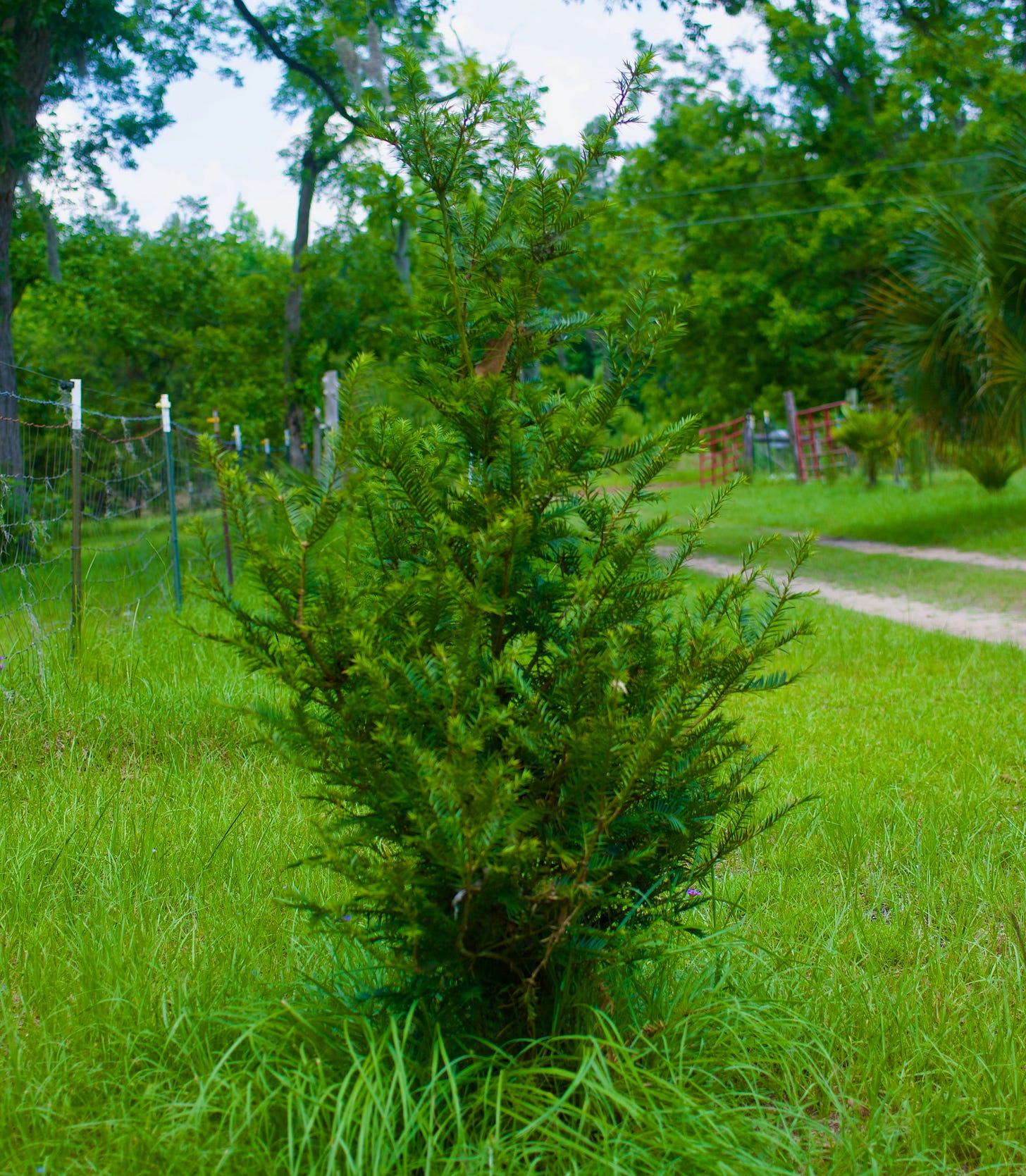IN MAY 2018 AT A meeting of the North Carolina Native Plant Society I was shopping at the silent auction when I saw two small, strange-looking trees that looked familiar.
They were labeled Torreya taxifolia.
I knew these trees from my life long ago in north Florida, where I went to college. I had applied for dozens of scholarships at Florida State, and I had extra money, a situation that seems strange and impossible now. My dad had drilled into me that, if I ever had money, I should buy land—it doesn’t go bad, it increases in value, it would be a place to live. So I used scholarship money to buy 12 acres in Gadsden County, about 30 miles west of Tallahassee, near a small community called Sycamore.
The closest public land was Torreya State Park, high bluffs along the Apalachicola River known as steepheads—glacial refugia—where grows one of the rarest trees in the world.
Torreya taxifolia, a member of the yew family, is known as Florida torreya, stinking-cedar, Florida nutmeg, and gopherwood.
Now here were two babies.
I asked around and soon was speaking with a couple who had propagated and grown these saplings, Lynda Anderson and Ken Conover. Because we don’t know how climate change will affect this most endangered of trees, Lynda and Ken were engaged in assisted migration, hoping to protect the Torreya by spreading it beyond its limited range.
“We have more saplings,” Lynda said. “If you have property we’d love to share them with you.”
About a month later the following note arrived.
Dear Janisse,
It was a pleasure meeting you several weeks ago in Franklin at the NCNPS meeting.
We are glad you are interested in growing Torreya taxifolia on your property in Georgia. We have set aside for you six plants similar in size to the ones you saw that we donated to the plant auction. They will make a nice grove and likely to have both female and male plants needed to make viable seeds.
Are you still interested in these plants? You are likely on your way to Clayton for the writer’s workshop. We live about 30 minutes from Clayton and would be glad to bring you the Torreya. We know you will be busy with the workshop so we could either leave the plants somewhere or we could meet you if convenient.
Lynda & Ken
Dear Lynda & Ken,
I would love to grow the Torreya. I hate to inconvenience you but I’d very much appreciate you bringing them to Parker Ranch. You are so kind and have such a good memory.
Janisse
Janisse,
We can bring them to the Parker Ranch sometime Saturday afternoon. We will take advantage of coming off our mountain to run other errands in Clayton.
Lynda & Ken
Lynda & Ken,
Thank you so much for the Torreya trees. They are beautiful and they rode home with us like children. I am proud to have this little grove.
I want to plant them soon, if you think it wise, because we are getting so much rain. I’m sure usually you would advise fall.
You are very kind to me.
Janisse
Hi Janisse,
Glad to hear that the babies made it safely to their new home.
While a fall planting is always best, you could plant now as long as you are able to nurture them and assure they get water during dry times so that the plants do not totally dry out. We suggest planting them at least 10 feet apart, well-drained soil (east or west-facing slope if you have it), and afternoon shade (but not constant shade that will suppress growth).Lynda & Ken
Lynda & Ken,
Oh dear. Here in south Georgia we have no slopes at all, at least no noticeable ones. The babies are beautiful. Thank you both so much for them.
All the best,
Janisse
Janisse,
A slope is not critical. I know people who grow them successfully on flat land. I think the critical thing is to assure they are well-drained, not sitting in marshy soil, and have partial shade to protect from the harsh afternoon sun.
Warm regards,
Lynda & Ken
That is our last email exchange. I planted the six trees along a section of the driveway, three on each side. They get afternoon shade. That was in July of 2018. The trees lived, flourished. They slowly grew, creeping to two feet then two and a half, then three.
Two years ago, one of them died.
Last year, another died.
Seven years later, four of the trees still line the driveway into our farm. I don’t know what their future holds, but here’s to hoping.
Forest Assisted Migration
If you want to learn more, read “Trees on the Move.”
Torreya Growing Instructions
SITE CONDITIONS: Based on their experience in the climate of Atlanta, the Atlanta Botanical Garden folks surmise that morning sun and afternoon shade is best to protect the trees from the hottest summer days. They also say that well-drained soils on slopes are the best places to have the plants grow.
STEEP SLOPES: Torreyas are superb at growing on slopes so steep you can't safely walk them. In such settings, they seem to do very well if planted right next to rocks and boulders that are themselves solidly embedded. Such rocks can also offer helpful shading of soil for moisture retention when the little seedlings are more vulnerable to drought and hot summer sun.
SLOPE ASPECT: Unless you have elevations of 5,000 feet or more, I would avoid direct south-facing slopes. East- or west-facing slopes are probably the best.
CHOICE OF CANOPY: I would definitely plant Torreya trees under some sort of semi-open canopy. Top choice would be under tall deciduous trees, so that they have full access to winter and spring sun and can get some mottled summer sun too.
Radical Sustainability
Where To See Torreya
1.
In March 2024 Sarah Horsley Adloo let me know that the Angus Gholson Nature Park in Chattahoochee, Fla. was being inducted into the Old-Growth Forest Network.
The invitation read, “Close to the border with Georgia and Alabama, this 126-acre park near the Apalachicola River hosts an outstanding diversity of native species across a wide gradient of habitat types, including upland slope forests, upland river escarpments, and a wide riverine floodplain. The steep ravines of this park are unusual in Florida, creating a landscape more akin to the hills of Appalachia than the flatlands of the Coastal Plain.”
Over 400 species of plants, including Florida Torreya, abound on the slopes and floodplains of the Angus Gholson Nature Park.
2.
Torreya State Park
3.
My driveway
The Other Thing We’re Growing
Study Memoir-Writing With Me This Summer Over Zoom
Starting in a week I’ll be teaching a memoir course for writers of all levels. We’ll meet for 12 weeks June 4 to August 20 Live via Zoom on Wednesdays from 11 am-12 noon Eastern US/Canada Time. Class time is one hour, with additional quiet co-working sessions and Q&A sessions. We’ll cover— Find the Story. What to Leave Out. What to Put In. Make Your Writing Come Alive. Pinpoint Theme & Mission. Outline It. Truth & Ethics: Nobody Gets Hurt. Honesty & Vulnerability. How to Protect Yourself. Research & Interview. Navigate Emotions. Place. Setting. Revise Revise Revise. How to Use AI. Get Published. Gather In Readers. Your investment— $300. Registration ends in 5 days.










love this story. It's nice to memorialize these kind people with special trees lining your driveway.
I love this! May those remaining Torreyas flourish, along with Fawn and you! Blessings and a hug, Susan